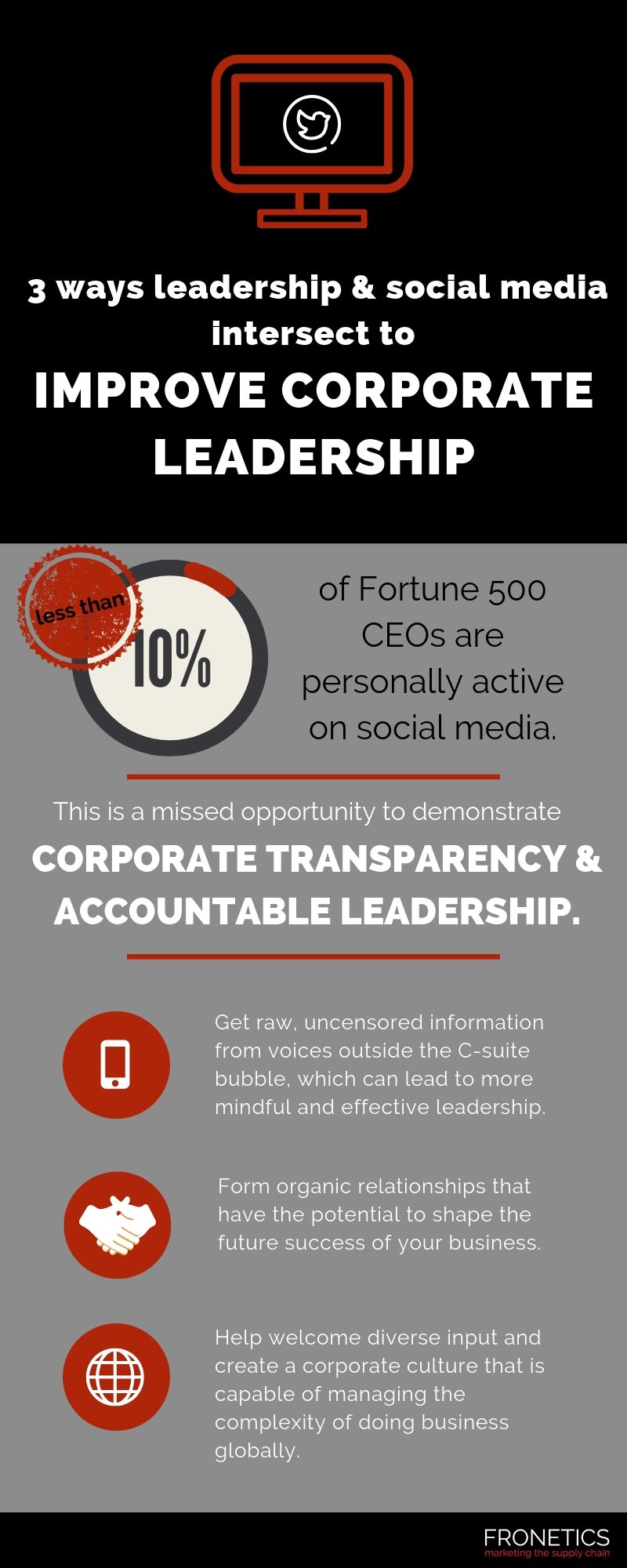The intersection of leadership and social media is receiving growing attention. A leadership expert has identified 3 surprising ways social media can create more effective leaders.
Highlights:
- Very few Fortune 500 CEOs are personally engaged in social media.
- Corporate leaders can get valuable unfiltered information through social media use and encourage a culture of free-flowing information.
- Social media’s transformative leadership effects can only come into play when leaders are personally engaged.
Social media is a nearly ubiquitous presence in our lives, both personal and professional. As the influence of these platforms extends, the connection between leadership and social media is increasingly gaining attention.
A recent report from Chief Executive found that the vast majority of American CEOs have no personal presence on social media, relying instead on ghostwriters or marketing staff to post on their behalf. Less than 10% of Fortune 500 CEOs are personally active on social media, despite growing public demand for corporate transparency and accountable leadership.
Engagement Leadership expert Céline Schillinger, in exploring the relationship between leadership and social media, has identified more than just the practical benefits (like strengthening brand, managing crises, and presenting a human face to the public) of CEOs on social media. Schillinger has identified three key ways that social media can actually create better leaders.
3 ways leadership and social media intersect to improve corporate leaders

1) Access to unfiltered information
One of the biggest changes that social media has wrought on modern society is the widespread, unfettered dissemination of information, directly from its source. Boiled down to its essence, social media gives everyone a voice. For today’s corporate leader, access to unfiltered information comes at a premium: “Be it competent and well-intended, or self-protective and risk averse, CEOs’ entourage form a distorting bubble,” writes Schillinger.
What better way than social media to burst the bubble and get the raw, uncensored information that leads to mindful and effective corporate leadership? It’s an ideal way to combat the gap in perception between employees and managers, for example, or the service gap between customer expectations and the customer experience. Using social media gives leaders access to real-time, accurate information from the people their businesses serve.
Schillinger says that the informational benefits of leadership and social media extend further. “By role modelling curiosity for unfiltered information and by exchanging thoughts and ideas directly through social media, leaders give symbolic ‘permission’ to their organization to do the same,” she writes. Social media can help leaders create a corporate culture that encourages the free flow of accurate, uncensored information.
2) Relational engagement and enhanced business performance
Best-selling author Brian Solis, who explores the effects of technology on business, marketing, and culture, writes, “Brands are co-created by consumers through shared experiences.” That’s actually a pretty radical message. Particularly for those of us in the marketing world, it’s easy to get caught up with the idea that brands are purely created through the careful work of marketing teams, designers, and image consultants.
But, in fact, what Solis is saying is that thanks in large part to social media, the totality of what makes up a brand identity no longer fits in the frame of what businesses create themselves. Brands are relational. For this reason, corporate leaders need to embrace the idea that effective leadership is “contextual and relational.”
“Relationship building is now a required core competency for all professionals — and for senior leaders in particular,” writes Schillinger. Social media gives leaders the opportunity to form the kinds or organic relationships that have no less than the potential to shape the core of their brands. These are “connections that arise within communities, born from a shared sense of belonging, acknowledgment of emotions, and co-creation of work.”
3) Transformation through mindset change: where leadership and social media intersect
Social media usage has transformational potential: it leads to new modes of interaction and relating to others. As Schillinger points out, “This is why it is fundamentally experiential and cannot be delegated without dampening its impact.” For corporate leaders, social media can help welcome diverse input and create a culture that is capable of managing the complexity of doing business in a global economy.
Schillinger identifies a powerful example of the transformative power of social media on corporate leaders, resulting in unmatched improvement in output. Corporate leaders at Sanofi Pasteur, a vaccines manufacturer, chose to personally involve themselves in an internal online community, interacting on a weekly basis with their employees. Their “asking questions, sharing insights, recognizing achievements, and ‘liking’ posts… had a huge positive impact on their own perception, their leadership, and the flows of knowledge between employees.”
The connection between effective leadership and social media participation is a topic that we’re really only beginning to understand. But what’s clear at this point is that when leaders commit to personal engagement in social platforms, information flows are enhanced, brands are strengthened, and the businesses unlock the kind of transformative potential that leads to unprecedented success.
Related posts:


